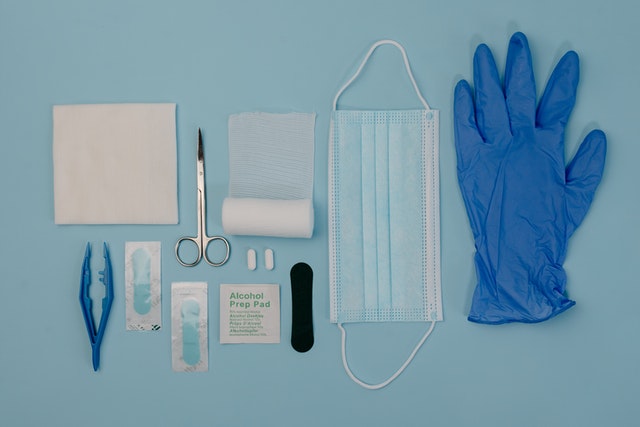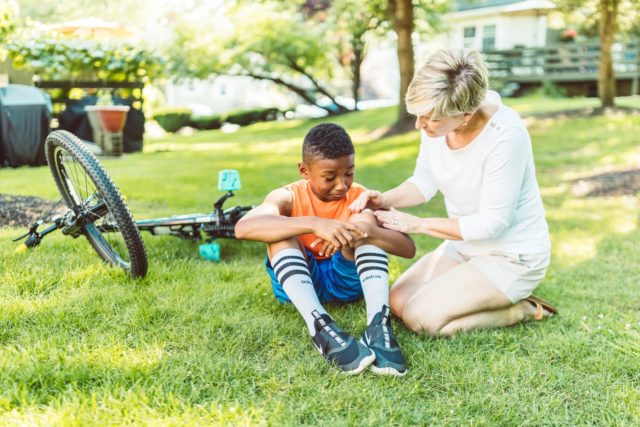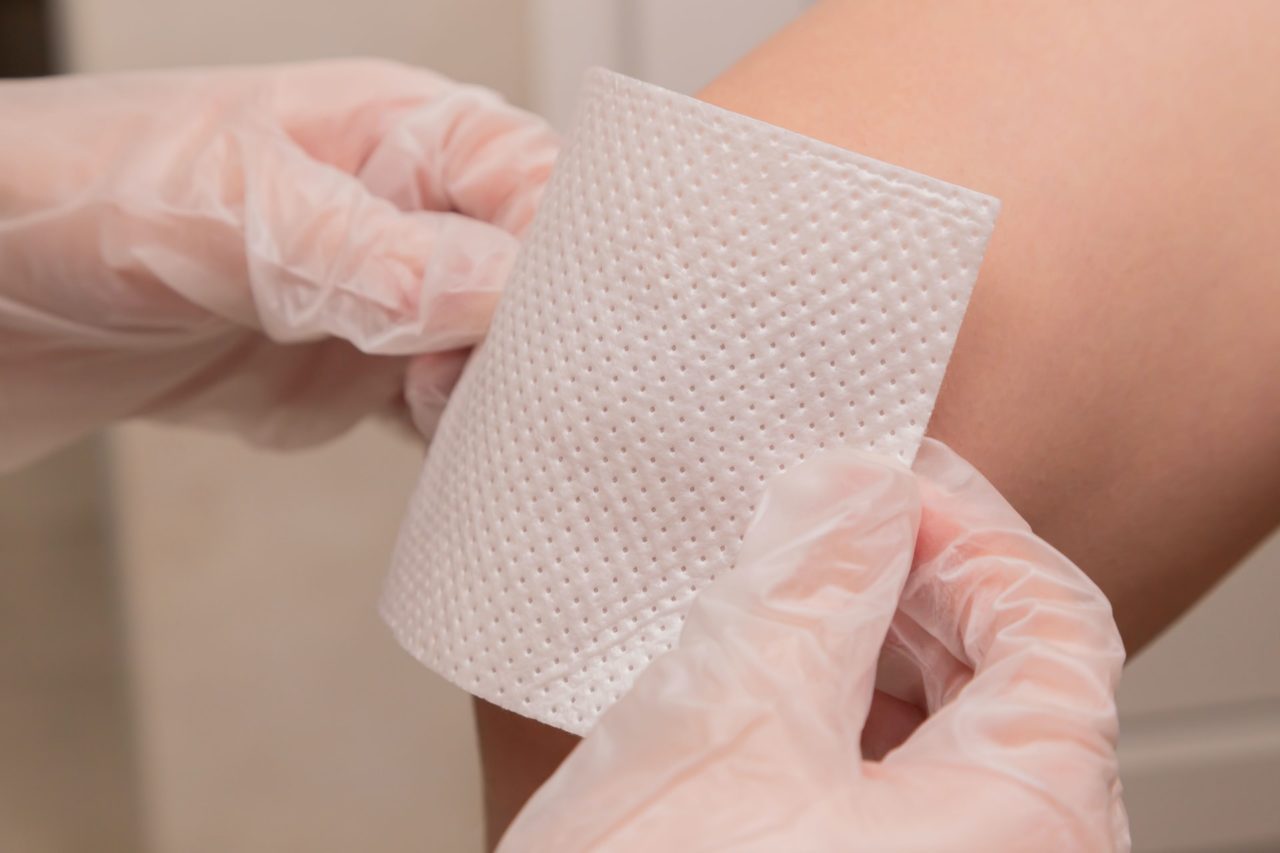Bleeding is a leading killer of patients suffering from trauma, but it’s also preventable with proper wound packing. Wound packing is one of the most basic medical skills.
Wound packing involves applying packing material to deep wounds. This absorbs the blood and protects the wound area. When a wound is improperly packed, it might close and look healed from the outside, but it will not heal on the inside. That’s why it’s vital to care for serious open wounds properly.
List of Equipment and Supplies You Need for Wound Packing
The standard equipment and supplies need for wound dressing include:
- packing material (gauze)
- cleaning solution (saline)
- sterile gloves
- scissors
- clean bowl
- clean towel
- bandages
- cotton swabs
- tape
- small plastic bag

Wound Packing in 3 Steps
There are three straightforward steps necessary for proper wound packing: preparation, packing, and dressing.
1. How to Prepare for Wound Packing
You always want to ensure that the environment around the patient and the supplies you will use are clean and sterile. Your hands will also need to be clean and sterile. That means that you should thoroughly wash your hands using soap and water, scrubbing up to your elbows, before putting on your gloves.
The next step is to rinse the patient’s wound using the cleaning solution. If there is crusting around in the area, you can use gauze dipped in the cleaning solution and carefully dab it.
You should clean the wound thoroughly before packing to remove any blood, puss, crust, or contaminants. If the wound has tunnels or narrow spots, be sure to rinse them thoroughly.
Always clean starting in the middle and moving out to avoid introducing bacteria from surrounding areas. Saline-soaked cotton swabs can remove stubborn grime.
2. How to Pack a Wound
Once you have adequately cleaned the area around the wound, you’ll want to start carefully inserting gauze into the wound. You can gently work the gauze into the open wound, guiding it with a cotton swab.
Don’t forget to wring out excess cleaning solution from the gauze. Be sure to use enough packing to completely fill the wound, but be careful not to pack too tightly. Any excess gauze that won’t fit can be gently piled on top and secured during dressing.
Packing a wound can be difficult and require additional work based on the wound’s shape and size. When packing a patient’s wound, be sure to communicate with them to ensure that you’re not causing discomfort by packing the wound too tightly.
3. How to Dress a Wound
Once you pack the wound, you’ll need to dress it. An outer dressing typically uses gauze squares to seal a packed wound to ensure adequate protection.
To dress the wound, simply layer the sterile gauze sponges atop the wound, covering the whole site. Next, secure the dressing with tape, 1-2 inches beyond the edges of the sound. Also, add some extra squares around the area for additional security. Be sure always to handle the gauze at its edges. Do not over-handle the gauze as this could risk infection.

Wound Packing FAQs
Wound packing becomes easier with practice. But, until you’re a wound packing pro, you may have questions. Find the answers here to eliminate your worries and calm your nerves before wound packing.
How Often Do You Need to Change Packing In a Wound?
How often you need to change the packing in a wound depends on what type of wound and the dressing type. Here are a few examples and the frequency in which you should change the wound packing.
- Standard Wound Packing | Twice a day
- Occlusive | Every 3-7 Days
- Hydrocolloid | Up to every 7 days
- Hydrogel | Every 2-3 days
How Long Can Packing Stay on the Wound?
Once you have packed the wound with sterile gauze, you should typically remove it within one or two days. Patients should consult their medical provider and follow their advice on removing the wound packing. Be sure to check the area around the wound regularly and watch for any signs of infection. If you suspect an infection, you should contact a healthcare professional immediately.
Is Packing a Wound Painful?
We’ll be honest. Packing a wound can be an uncomfortable experience. But, with proper technique, pain and discomfort can easily be minimized.
Should I Pack an Abscess?
The purpose behind abscess packing is to help absorb excess fluid. It also prevents infection and incisions from closing prematurely. When packed properly, the abscess can continue to drain, which is necessary for proper healing.
However, among most medical professionals, the answer to this question is a resounding no. More studies and research will make it more and more apparent that packing abscesses to help them heal faster is a fruitless endeavor.
When to Call For Help
When you suffer a severe wound that’s bleeding profusely, you should immediately call for medical attention.
However, there are other situations where you should seek immediate medical attention, including:
- a foreign object (metal, wood, soil, or another object) is inside the wound.
- the wound resulted from an animal bite.
- the wound resulted from a puncture from a dirty object.
- a wound has become infected. Signs of an infection include fever, draining, redness, swelling, soreness, or pain.
- you suspect that you’re suffering from sepsis. Signs of sepsis include disorientation and confusion. Other signs include increased heart rates, fever, shortness of breath, discomfort, and sweaty skin
In these situations, calling 911 promptly can save a life.
Anyone with a severe wound should get an evaluation for tetanus immunization. It’s vital for patients that have suffered puncture wounds or are suffering from a wound contaminated with saliva, soil, or feces. A medical professional can determine if you need a tetanus booster based on your history.
Learn More About First Aid
Here at Elite, we’re passionate about providing the best emergency and non-emergency medical transportation for Chicago. But, we also love educating people on first aid dos and don’ts.
After all, you don’t need to be an EMT to save a life. Check out the Elite blog for more tips on first aid.
If you do think saving lives is your calling, the Elite Ambulance Academy provides courses to start your career in medical transportation.
Learn more about our courses and career paths!
Comments are closed.



Recent Comments